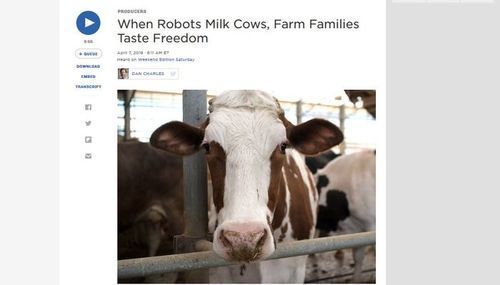
Automation: Robots Milking Cows In Some Dairies Now — Where Will The Illegal Aliens Go?
By Allan Wall
05/10/2018
NPR ran a report last month on the use of robots in dairies, highlighting the experience of one dairy family in Michigan. [When Robots Milk Cows, Farm Families Taste Freedom, by Dan Charles, NPR, April 7, 2018] Having lived and worked on a dairy myself, I can appreciate this.
A dairy provides a steady stream of income but on the other hand it really keeps you committed to doing the same thing day in and day out. Cows, after all, do not recognize any sort of holiday when it comes to being milked. And dairy cows get uncomfortable when they don’t get milked.
The article aptly describes the dairy lifestyle: “Those two daily appointments with the cows were the fixed poles of their life; everything else had to be arranged around them."
But now the Shulers have switched over to a robotic dairy. Rather than milking all the cows at once, each cow, on her own, goes into the milking facility when she feels ready to be milked.
Of course, there is still work to done on a dairy, but the actual milking is done by the robots. The dairyman just has to monitor the robot to make sure it’s working properly. But dairies that go robot are not going to need workers to milk the cows.
According to Dan Charles of NPR:
Robots like these are milking a small minority of America’s cows — a representative from DeLaval, the company that made Schuster’s robots, estimates that it’s about 5 percent. But the share is growing.
How’s that going to affect labor arrangements?
Big dairies are buying them to replace hired workers, many of them immigrants, because recruiting and keeping those workers is getting much more difficult.
A dairy needs labor, because someone has to milk the cows. My brother is still in the dairy business, and he and his wife solved their labor problem by having eight children.
Many dairies, however, went the illegal alien labor route. (See Family Dairy Farms: Killed by Illegal Immigration, by Patrick Cleburne.)
But now, with the use of robots on dairies, that could change. Today it’s 5% of dairies with robots, but that seems likely to grow.
It’s yet another example of how importing cheap labor is a strategy of the past, not the future. The U.S. will be doing well to even have jobs for all its people, so why import more workers?
It’s yet another reason for an immigration shutdown.
